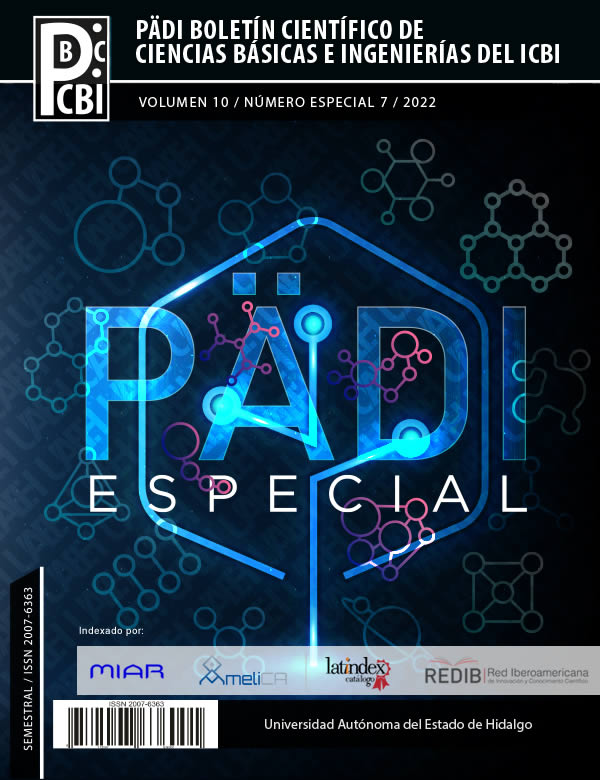Obtaining metallic copper from the leaching of mining tailings originating in the state of zacatecas
Abstract
The mineralogical characterization during the evaluation of the potential generator of acid drainage for a sample of mining tailings originating from Sombrerete Zacatecas showed that the pyrite is occluded in the silicates, thus reducing the risk of dissolution of potentially toxic metals. Therefore, the quantification of the concentration of base metals (Cu, Pb and Zn) together with the sequential extraction revealed the presence of approximately 6kg of Cu/ton of mining tailings. In addition, 80% of copper is in the form of carbonates, oxides and sulfides, so a hydrometallurgical process was proposed using a 0.2M sulfuric acid leaching solution, followed by copper enrichment through solvent extraction. and its metallic obtaining via electrodeposition, respectively. This process demonstrated that mining tailings are mining residues that can be considered value-added materials and secondary sources for metal recovery.
Downloads
References
Araya, N., Kraslawski, A., Cisternas, L. A. (2020). Towards mine tailings valorization: Recovery of critical materials from Chilean mine tailings. Journal of Cleaner Production, 263, 121555.
Araya, N., Ramírez, Y., Kraslawski, A., Cisternas, L. A. (2021). Feasibility of re-processing mine tailings to obtain critical raw materials using real options analysis. Journal of Environmental Management, 284, 112060.
Armienta, M. A., Mugica, V., Reséndiz, I., Arzaluz, M. G. (2016). Arsenic and metals mobility in soils impacted by tailings at Zimapán, México. Journal of soils and sediments, 16(4), 1267-1278.
de la Torre, J. A. F., Mitchell, K., Gómez, M. S. R., Barrera, A. L. G., Flores, L. Y., González, F. J. A. (2018). Effect of plant growth on Pb and Zn geoaccumulation in 300-year-old mine tailings of Zacatecas, México. Environmental earth sciences, 77(10), 386.
Dold B. (2003). Speciation of the most soluble phases in a sequential extraction procedure adapted for geochemical studies of copper sulphide mine waste. J Geochem Explor 80:55–68Return to ref 2003 in article
Gómez-Bernal, J. M., Ruiz-Huerta, E. A., Armienta-Hernández, M. A., Luna-Pabello, V. M., 2017. Evaluation of the removal of heavy metals in a natural wetland impacted by mining activities in Mexico. Environmental earth sciences, 76(23), 801.
Hall GEM., Vaive JE., Beer R., Hoashi M. (1996). Selective leaches revisited, with emphasis on the amorphous Fe oxyhydoxide phase extraction. J Geochem Explor 56:59–78
Hernández-Mendiola, E., Romero, F. M., Gutiérrez-Ruiz, M., Rico, C. A. M. (2016). Solid phases controlling the mobility of potentially toxic elements and the generation of acid drainage in abandoned mine gold wastes from San Antonio–El Triunfo mining district, Baja California Sur, México. Environmental Earth Sciences, 75(11), 969.
Kuranchie, F. A., Shukla, S. K., Habibi, D., Mohyeddin, A. (2015). Utilisation of iron ore tailings as aggregates in concrete. Cogent Engineering, 2(1), 1083137
Nwaila, G. T., Ghorbani, Y., Zhang, S. E., Frimmel, H. E., Tolmay, L. C., Rose, D. H., Bourdeau, J. E. (2021a). Valorisation of mine waste-Part I: Characteristics of, and sampling methodology for, consolidated mineralised tailings by using Witwatersrand gold mines (South Africa) as an example. Journal of Environmental Management, 295, 113013.
Nwaila, G. T., Ghorbani, Y., Zhang, S. E., Tolmay, L. C., Rose, D. H., Nwaila, P. C., Frimmel, H. E. (2021b). Valorisation of mine waste-Part II: Resource evaluation for consolidated and mineralised mine waste using the Central African Copperbelt as an example. Journal of Environmental Management, 299, 113553.













